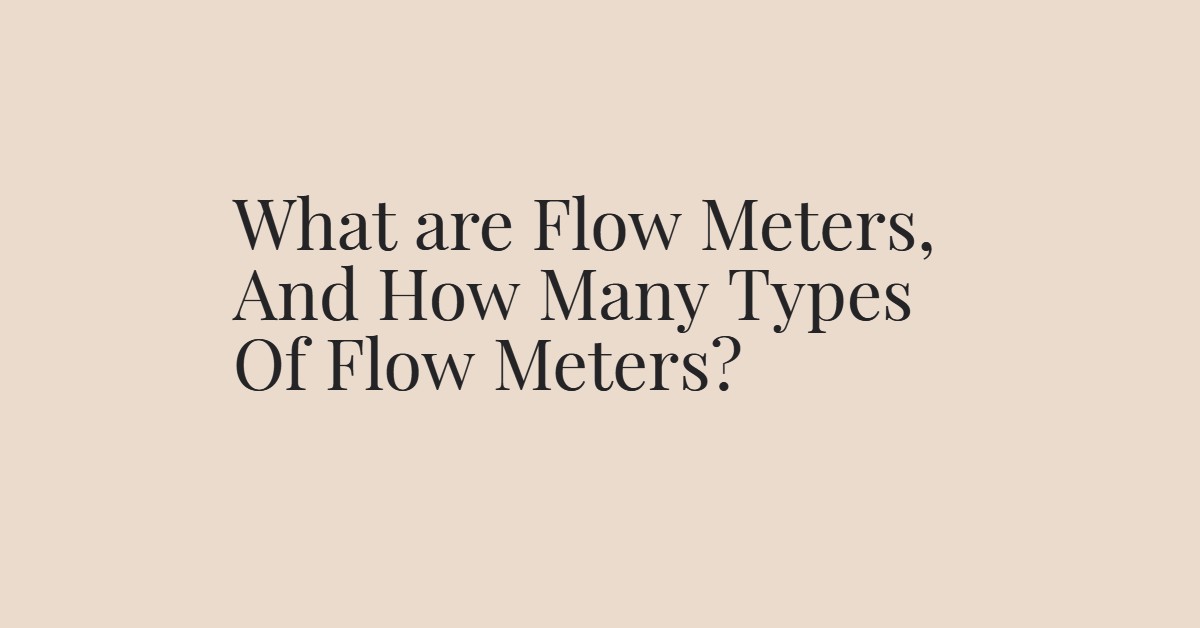What are Flow Meters, And How Many Types Of Flow Meters?

Flow meters are important devices. It is used in both industrial and residential applications. They are usually small to medium-sized devices that work to measure the flow of liquids and gases. A flow meter or sensor or controller, or indicator can measure the accurate amount of liquids in the pipes. It describes the measurement in the form of flow rate. The fundamental purpose of the flow meter is to ensure proper liquid management. They can detect and ensure if there is any leakage or wastage of the water or other liquids. There are different types of flow meters that, We are describing in this blog. Therefore, if you want to attain useful knowledge about these devices, read this blog cautiously.
What do flow meters do?
As mentioned above that these devices aim to measure and monitor the flow rate of fluids. They are used to gauge the flow in specific containers such as tanks, pipes, and industrial chambers, etc. However, their work also depends on different technical and mechanical aspects. They also are equipped with different features. The working of these meters is considerably active in the industries such as:
- Chemical
- Food processing and packaging
- Power generation
- Wastewater treatments
- Petrochemicals
- Paints and paper industry etc
Differential pressure flow controllers
As the name states, these controllers measure the flow rate with the change in pressure of the fluids flowing in the pipelines. They mainly work to monitor the flow rate when the speed of flow is increase, and pressure decreases. There are primary and secondary measurements use by these meters to derive accurate flow measurements. The rate of flow is measured as per the pressure drop. As higher as the pressure drops, the flow rate is higher. These meters are further classified into different types. You can see these meters with an orifice plate, Rotameters, venturi tube, and flow nozzle, etc.
Velocity flow controllers
The principle of measuring flow rate using the speed of flow is applicable to these meters. They are also known to calculate the velocity flow rate of the liquids flowing inside the pipes. By using these devices, you can read the flow measurement using depth and average airspeed of the flow. These meters are further classified into sub-types such as:
Turbine flow indicators:
These meters are used for calculating flow velocity using the turbines. They are free rotors that move along with the fluid flow.
Pitot tube:
These meters are primarily useful for deriving accurate flow measurements for HVAC systems. HVAC systems are commonly used in residential buildings as well. They can monitor the velocity of liquids and gases by translating kinetic energy into probable energy.
Electromagnetic flow controllers:
The flow rate is measure by using the magnetic field by reading the voltage generated. The sensor of this meter tells about the voltage generated as the liquid passes through the magnetic field. However, this meter application is mainly useful to measure the slurry fluids.
Vortex flow controllers
Among the types of flow meters, the name of vortex flow meter is considerable. This meter measures the speed of fluids by directly obstructing the flow path. The fluid passes through its bluff body causes the fluid to generate vortices that help engineers to read flow rate.
Ultrasonic flowmeters
These are also velocity measuring meters that work by sending ultrasound waves from one transducer to another. These meters measure the travel time for the waves that travel from one point to another and back. These meters are further divide into two categories as Transit-time and Doppler Effect.
Positive displacement meters
These meters are perfectly suitable for measuring the thickness and slurry liquids. They use sensors and rotors to measure the flow rate of the liquids such as water and chemicals. The rotation of the rotors of this meter is linked with the flow of the fluid. These meters work best when there is a problem with measuring the flow rate of liquids flowing in non-straight pipes. PD flowmeters are good alternatives for turbine and paddlewheel meters.
Mass flow controllers
These devices use the mass flow rate to divide it with the fluid density. These measuring tools utilize the Coriolis Effect to read accurate flow rates.
Open channel flow sensors
These meters are use to measure the flow rate for liquids that are exposed to an open environment. They are primarily used for open water tanks and other open channels.
What are the best types of flow meters?
Well, all these above-mentioned flow meters are good. These are best to work for measuring the flow rate for liquids and gases. They are firmly featured to deliver accurate results for measuring the fluids. But, their work might differ due to several factors. So, it is essential to choose one as per your specific flow measurement requirements.
How to install a flow meter?
It is quite simple to install these devices to work for measuring the flow rate of liquids and gases.
- Identify the right place to install the flow meter
- Recognize the direction of the flow that you want to measure
- Make pipe expansion if required to get accurate results
- Consider an extra pipeline for uninterrupted flow of liquids at the time of repairs
- Follow the guidelines to install the flow meters properly.
- Ensure the pipeline is filled with the liquid or gases that you want to measure.
To Wind Up
These are different types of flow meters that are available in the market easily. It is vital to get the flow meters from professional suppliers. You cannot compromise the flow rate results to maintain quality and control during industrial processes.




